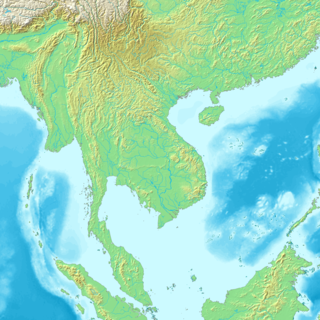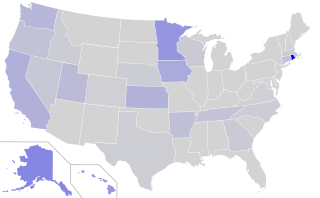| Laos at the 2019 World Aquatics Championships | |
|---|---|
 | |
| FINA code | LAO |
| National federation | Laos Swimming Federation |
| World Aquatics Championships appearances | |
Laos competed at the 2019 World Aquatics Championships in Gwangju, South Korea from 12 to 28 July.
| Laos at the 2019 World Aquatics Championships | |
|---|---|
 | |
| FINA code | LAO |
| National federation | Laos Swimming Federation |
| World Aquatics Championships appearances | |
Laos competed at the 2019 World Aquatics Championships in Gwangju, South Korea from 12 to 28 July.
Laos entered three swimmers. [1]
| Athlete | Event | Heat | Semifinal | Final | |||
|---|---|---|---|---|---|---|---|
| Time | Rank | Time | Rank | Time | Rank | ||
| Santisouk Inthavong | 50 m freestyle | 25.79 | 109 | did not advance | |||
| 50 m backstroke | 30.75 | 67 | did not advance | ||||
| Slava Sihanouvong | 50 m breaststroke | 32.11 | 64 | did not advance | |||
| 50 m butterfly | 30.40 | 88 | did not advance | ||||
| Athlete | Event | Heat | Semifinal | Final | |||
|---|---|---|---|---|---|---|---|
| Time | Rank | Time | Rank | Time | Rank | ||
| Siri Arun Budcharern | 50 m freestyle | 31.32 | 88 | did not advance | |||
| 50 m breaststroke | 40.72 | 48 | did not advance | ||||

Laos, officially the Lao People's Democratic Republic, is the only landlocked country in Southeast Asia. It is bordered by Myanmar and China to the northwest, Vietnam to the east, Cambodia to the southeast, and Thailand to the west and southwest. Its capital and most populous city is Vientiane. The country is characterized by mountainous terrain, Buddhist temples including the UNESCO World Heritage site of Luang Prabang, and French colonial architecture.

The economy of Laos is a lower-middle income developing economy. Being a socialist state, the Lao economic model resembles the Chinese socialist market and/or Vietnamese socialist-oriented market economies by combining high degrees of state ownership with openness to foreign direct investment and private ownership in a predominantly market-based framework.

The foreign relations of Laos, internationally designated by its official name as the Lao People's Democratic Republic, after the takeover by the Pathet Lao in December 1975, were characterized by a hostile posture toward the West, with the government of the Lao People's Democratic Republic aligning itself with the Soviet bloc, maintaining close ties with the Soviet Union and depending heavily on the Soviets for most of its foreign assistance. Laos also maintained a "special relationship" with Vietnam and formalized a 1977 treaty of friendship and cooperation that created tensions with China.

Mainland Southeast Asia is the continental portion of Southeast Asia. It lies east of the Indian subcontinent and south of Mainland China and is bordered by the Indian Ocean to the west and the Pacific Ocean to the east. It includes the countries of Cambodia, Laos, Myanmar, Thailand and Vietnam as well as Peninsular Malaysia.

The Mekong or Mekong River is a transboundary river in East Asia and Southeast Asia. It is the world's twelfth-longest river and the third-longest in Asia with an estimated length of 4,909 km (3,050 mi) and a drainage area of 795,000 km2 (307,000 sq mi), discharging 475 km3 (114 cu mi) of water annually. From its headwaters in the Tibetan Plateau, the river runs through Southwest China, Myanmar, Laos, Thailand, Cambodia, and southern Vietnam. The extreme seasonal variations in flow and the presence of rapids and waterfalls in the Mekong make navigation difficult. Even so, the river is a major trade route between Tibet and Southeast Asia. The construction of hydroelectric dams along the Mekong in the 2000s through the 2020s has caused serious problems for the river's ecosystem, including the exacerbation of drought.

Luang Prabang, historically known as Xieng Thong (ເຊືອງທອງ) and alternatively spelled Luang Phabang or Louangphabang, is the capital of Luang Prabang Province in north-central Laos. Its name, meaning “Royal Buddha Image,” derives from the Phra Bang, a revered statue symbolizing Lao sovereignty. Designated a UNESCO World Heritage Site in 1995, the city is recognized for blending traditional Lao architecture, European colonial buildings, and over 30 Buddhist temples. The protected area encompasses 33 of its 58 villages, where daily rituals like the morning alms-giving ceremony persist.

The Pathet Lao, officially the Lao People's Liberation Army, was a communist political movement and organization in Laos, formed in the mid-20th century. The group ultimately gained control over the entire country of Laos in 1975, after the Laotian Civil War. The Pathet Lao were always closely associated and dependent on Vietnamese communists and North Vietnam since their foundation, with the group being established after advice from Hanoi to create a Laotian counterpart of the Viet Minh or Viet Cong. During the civil war, it was effectively organised, equipped and even led by the People's Army of Vietnam (PAVN). They fought against the anti-communist forces in the Vietnam War. Eventually, the term became the generic name for Laotian communists. Under orders from Mao Zedong, the People's Liberation Army provided 115,000 guns, 920,000 grenades and 170 million bullets, and trained more than 700 of its military officers.

Laotian Americans are Americans who trace their ancestry to Laos. Laotian Americans are included in the larger category of Asian Americans. The major immigrant generation were generally refugees who escaped Laos during the warfare and disruption of the 1970s, and entered refugee camps in Thailand across the Mekong River. They emigrated to the United States during the late 1970s and throughout the 1980s.

The president of the Lao People's Democratic Republic is the head of state of Laos. The current president is Thongloun Sisoulith, since 22 March 2021. He was previously elected as the General Secretary of the Lao People's Revolutionary Party, Laos' most powerful position in January 2021, ranking him first in the Politburo.

Lao-Lao is a Laotian rice whisky produced in Laos. Along with Beerlao, lao-Lao is a staple drink in Laos.

The Ministry of Foreign Affairs is the government ministry responsible for representing Laos to the international community. The ministry oversees the foreign relations of Laos, maintains diplomatic missions in other countries, and provides visa services.

Lesbian, gay, bisexual and transgender (LGBT) rights in Laos go unreported and unnoticed. While homosexuality is legal in Laos, it is very difficult to assess the current state of acceptance and violence that LGBTQ people face because of government interference. Numerous claims have suggested that Laos is one of the most tolerant communist states. Despite such claims, discrimination still exists. Laos provides no anti-discrimination protections for LGBT people, nor does it prohibit hate crimes based on sexual orientation and gender identity. Households headed by same-sex couples are not eligible for any of the rights that opposite-sex married couples enjoy, as neither same-sex marriage nor civil unions are legal.

Vientiane is the capital and largest city of Laos. Situated on the banks of the Mekong River at the Thai border, it comprises the five urban districts of Vientiane Prefecture and had a population of 840,000 as of the 2023 Census. Established as the capital of the Lan Xang Kingdom in 1563, Vientiane served as the administrative center during French rule and retains colonial-era architecture alongside Buddhist landmarks such as Pha That Luang, a national symbol of Buddhism, and Haw Phra Kaew, which once housed the Emerald Buddha until its 18th-century relocation to Thailand.

Or Lam is a mildly spicy, slightly tongue numbing, Laotian stew originating from Luang Prabang, Laos. The peppery and thick broth is prepared by slowly simmering lemongrass, chilies and Lao chili wood (sakhaan) with crushed or mashed up sticky rice, grilled citronella, garlic, dill and onions added to thicken the broth.

Visitors to Laos must obtain a visa from one of the Laotian diplomatic missions unless they are citizens of one of the visa-exempt countries or citizens eligible for a visa on arrival or an e-Visa. All visitors must hold a passport valid for 6 months.

The Boten–Vientiane railway is the Lao section of the Laos–China Railway (LCR), running between the capital Vientiane and the northern town of Boten on the border with Yunnan, China. The line was officially opened on 3 December 2021.

Laos participated in the 2018 Asian Games in Jakarta and Palembang, Indonesia from 18 August to 2 September 2018. Laos first competed at the Asian Games in 1974 Tehran, and the best achievement was in the last edition of 2014 Incheon, when the country gained a silver, and 2 bronze medals.
The COVID-19 pandemic in Laos is part of the worldwide pandemic of coronavirus disease 2019 caused by severe acute respiratory syndrome coronavirus 2. On 24 March 2020, Laos became the last country in Southeast Asia to report its confirmed case of the virus. As of 5 June 2022, there were a total of 210,081 cases and 756 deaths. On 4 May 2021, Laos exceeded 1,000 cases of COVID-19. Five days later, the country recorded the first death.

Miss Grand Laos is an annual female national beauty pageant of Laos, founded by Miss Laos Company Limited in 2017. The winner of which represents the country at its parent contest Miss Grand International. Since 2019, the franchise of the contest has belonged to Prime Modeling Agency which is managed by Saikeo Sidavong.

Germany–Laos relations have existed on the bilateral level since the late 1950s.